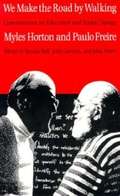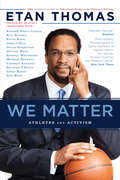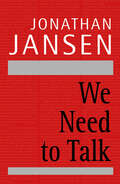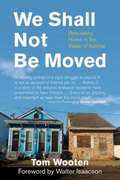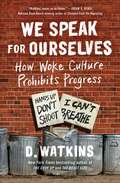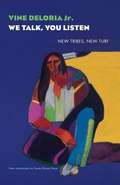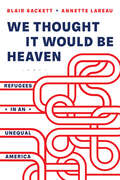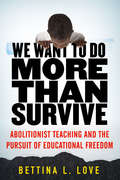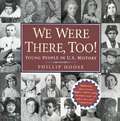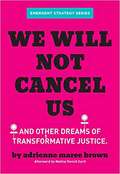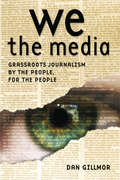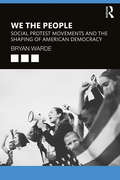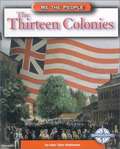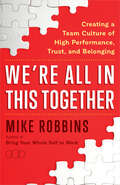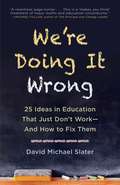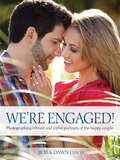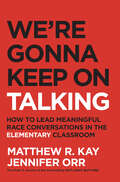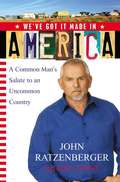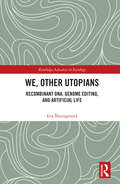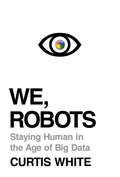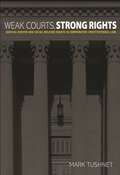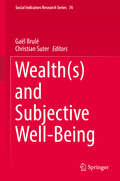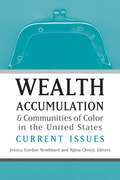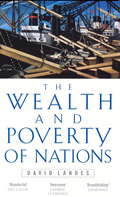- Table View
- List View
We Make the Road by Walking: Conversations on Education and Social Change
by Myles Horton Paulo Freire Brenda Bell John Gaventa John PetersIn December 1987, Myles Horton and Paulo Freire, two pioneers of education for social change, came together to "talk a book" about their experiences and ideas. Though they came from different environments--one from the rural mountains of Appalachia, the other from São Paulo, the largest industrial city in Brazil--Myles and Paulo shared a vision and a history of using participatory education as a crucible for empowerment of the poor and powerless.
We Matter: Athletes and Activism
by Etan ThomasInterviews with sports stars, activists, surviving family members, and others fighting racial injustice: &“Before Kaepernick, there was Etan Thomas.&”—The New York TimesA Library Journal Best Book of the YearProfessional athletes have long been influential figures in American life. Today, many of them are using their platforms to speak up about injustice and inequality. This book features interviews by former NBA player Etan Thomas with over fifty athletes, executives, media figures, and more—interwoven with essays and critiques by Thomas.Includes personal stories and opinions from:Kareem Abdul-Jabbar, Bill Russell, Dwyane Wade, Russell Westbrook, Steve Kerr, Oscar Robertson, Mark Cuban, Michael Bennett, Carmelo Anthony, Derrick Rose, Swin Cash, Alonzo Mourning, Chris Webber, Jemele Hill, Anquan Boldin, Jamal Crawford, Juwan Howard, Ray Jackson, Shannon Sharpe, James Blake, John Carlos, Laila Ali, Michael Eric Dyson, Joakim Noah, Eric Reid, Adam Silver, Soledad O'Brien, John Wall, Mahmoud Abdul-Rauf, Bradley Beal, Tamika Catchings, Curtis Conway, Harry Edwards, Chris Hayes, Chamique Holdsclaw, Scoop Jackson, Bomani Johnes, Shaun King, Jimmy King, Ted Leonsis, Thabo Sefolosha, Ilyasah Shabazz, Torrey Smith, Kenny Smith, Michael Smith, David West, Michael Wilbon, Jahvaris Fulton (brother of Trayvon Martin), Emerald Snipes (daughter of Eric Garner), Allysza Castile (sister of Philando Castile), Valerie Castile (mother of Philando Castile), and Dr. Tiffany Crutcher (sister of Terence Crutcher)&“In We Matter, Thomas strives to show the influence professional athletes can have when they join the conversation on race, politics, and civil rights. Thomas conducted 50 interviews, which included Kareem Abdul-Jabbar, Bill Russell, Laila Ali, Michael Bennett, and Eric Reid, among many other athletes, as well as journalists, television personalities, and family members of unarmed black men who were shot and killed. Thomas also explored his ties with the Wizards and spoke with John Wall, Bradley Beal, and current majority team owner Ted Leonsis.&”—TheWashington Post&“The honest conversations, published in transcript form and often accompanied by black-and-white photos, serve as a primer on recent police violence cases, a history lesson on the first athletes who stood up for racial injustice, an examination of the experience of being young and black in the United States, and an insightful look at how it feels to lose a loved one to tragedy, from contributors such as Jemele Hill, Kareem Abdul-Jabbar, and Carmelo Anthony...An important read, executed uniquely.&”—School Library Journal (starred review) &“Voices of pain, anger, and hope resound through these pages--and through the reader's heart.&”—Kirkus Reviews
We Shall Not Be Moved
by Tom Wooten“It was heartbreaking, but we couldn’t give up. I just said, ‘Well, I’ve got to get in and do it. ’”—Phil Harris, eight-decade-long resident of Hollygrove As floodwaters drained in the weeks following Hurricane Katrina, New Orleans residents came to a difficult realization. Their city was about to undertake the largest disaster recovery in American history, yet they faced a profound leadership vacuum: members of every tier of government, from the municipal to the federal level, had fallen down on the job. We Shall Not Be Movedtells the absorbing story of the community leaders who stepped into this void to rebuild the city they loved. From a Vietnamese Catholic priest who immediately knows when two of his six thousand parishioners go missing to a single mother from the Lower Ninth Ward who instructs the likes of Jimmy Carter and Brad Pitt, these intrepid local organizers show that a city’s fate rests on the backs of its citizens. On their watch, New Orleans neighborhoods become small governments. These leaders organize their neighbors to ward off demolition threats, write comprehensive recovery plans, found community schools, open volunteer centers, raise funds to rebuild fire stations and libraries, and convince tens of thousands of skeptical residents to return home. Focusing on recovery efforts in five New Orleans neighborhoods—Broadmoor, Hollygrove, Lakeview, the Lower Ninth Ward, and Village de l’Est—Tom Wooten presents vivid narratives through the eyes and voices of residents rebuilding their homes, telling a story of resilience as entertaining as it is instructive. The unprecedented community mobilization underway in New Orleans is a silver lining of Hurricane Katrina’s legacy. By shedding light on this rebirth,We Shall Not Be Movedshows how residents, remarkably, turned a profound national failure into a story of hope. From the Hardcover edition.
We Speak for Ourselves: A Word from Forgotten Black America
by D. WatkinsFrom the row houses of Baltimore to the stoops of Brooklyn, with searing conviction and full compassion, D. Watkins, New York Times bestselling author of The Cook Up and The Beast Side lays bare the voices of the most vulnerable and allows their raw, intimate stories to uncover the systematic injustice threaded within our society. Honest and eye-opening, We Speak for Ourselves makes us listen, feel, and create a course toward change that starts right where we are.Watkins introduces you to Down Bottom, the storied community of East Baltimore that holds a mirror to America’s poor black neighborhoods—“hoods” that could just as easily be in Chicago, Detroit, Oakland, or Atlanta. As Watkins sees it, the perspective of people who live in economically disadvantaged black communities is largely absent from the commentary of many top intellectuals who speak and write about race. Unapologetic and sharp-witted, D. Watkins is here to tell the truth as he has seen it. We Speak for Ourselves offers an in-depth analysis of inner-city hurdles and honors the stories therein. We sit in underfunded schools, walk the blocks burdened with police corruption, stand within an audience of Make America Great Again hats, journey from trap house to university lecture, and rally in neglected streets. And we listen. Watkins shares the lessons he has learned while navigating through two very distinct worlds—the hood and the elite sanctums of prominent black thinkers and public figures—serving hope to fellow Americans who are too often ignored and calling on others to examine what it means to be a model activist in today’s world. We Speak for Ourselves is a must-read for all who are committed to social change.
We Talk, You Listen: New Tribes, New Turf
by Vine Deloria Jr."We Talk, You Listen" is strong, boldly unconventional medicine from Vine Deloria Jr., one of the most important voices of twentieth-century Native American affairs. He turns his penetrating vision toward the disintegrating core of American society. Written at a time when the traditions of the formerly omnipotent Anglo-Saxon male were crumbling under the pressures of a changing world, Deloria's book interprets racial conflict, inflation, the ecological crisis, and power groups as symptoms rather than causes of the American malaise: "The glittering generalities and mythologies of American society no longer satisfy the need and desire to belong", a theory as applicable today as it was in 1970. American Indian tribalism, according to Deloria, was positioned to act as America's salvation. Deloria proposes a uniquely Indian solution to the legacy of genocide, imperialism, capitalism, feudalism, and self-defeating liberalism: group identity and real community development, a kind of neo-tribalism. He also offers a fascinating cultural critique of the nascent "tribes" of the 1970s, indicting Chicanos, blacks, hippies, feminists, and others as misguided because they lacked comprehensive strategies and were led by stereotypes rather than an understanding of their uniqueness.
We Thought It Would Be Heaven: Refugees in an Unequal America
by Annette Lareau Blair SackettResettled refugees in America face a land of daunting obstacles where small things—one person, one encounter—can make all the difference in getting ahead or falling behind. Fleeing war and violence, many refugees dream that moving to the United States will be like going to Heaven. Instead, they enter a deeply unequal American society, often at the bottom. Through the lived experiences of families resettled from the Democratic Republic of the Congo, Blair Sackett and Annette Lareau reveal how a daunting obstacle course of agencies and services can drastically alter refugees’ experiences building a new life in America. In these stories of struggle and hope, as one volunteer said, "you see the American story." For some families, minor mistakes create catastrophes—food stamps cut off, educational opportunities missed, benefits lost. Other families, with the help of volunteers and social supports, escape these traps and take steps toward reaching their dreams. Engaging and eye-opening, We Thought It Would Be Heaven brings readers into the daily lives of Congolese refugees and offers guidance for how activists, workers, and policymakers can help refugee families thrive.
We Want to Do More Than Survive: Abolitionist Teaching and the Pursuit of Educational Freedom
by Bettina LoveDrawing on personal stories, research, and historical events, an esteemed educator offers a vision of educational justice inspired by the rebellious spirit and methods of abolitionists.Drawing on her life's work of teaching and researching in urban schools, Bettina Love persuasively argues that educators must teach students about racial violence, oppression, and how to make sustainable change in their communities through radical civic initiatives and movements. She argues that the US educational system is maintained by and profits from the suffering of children of color. Instead of trying to repair a flawed system, educational reformers offer survival tactics in the forms of test-taking skills, acronyms, grit labs, and character education, which Love calls the educational survival complex. To dismantle the educational survival complex and to achieve educational freedom--not merely reform--teachers, parents, and community leaders must approach education with the imagination, determination, boldness, and urgency of an abolitionist. Following in the tradition of activists like Ella Baker, Bayard Rustin, and Fannie Lou Hamer, We Want to Do More Than Survive introduces an alternative to traditional modes of educational reform and expands our ideas of civic engagement and intersectional justice.
We Were There,Too!: Young People in US History
by Phillip HooseBiographies of dozens of young people who made a mark in American history, including explorers, planters, spies, cowpunchers, sweatshop workers, and civil rights workers.
We Will Not Cancel Us: Breaking The Cycle Of Harm (Emergent Strategy Series)
by Adrienne Maree Brown Malkia Devich-CyrilCancel culture addresses real harm...and sometimes causes more. It’s time to think this through. <P><P> “Cancel” or “call-out” culture is a source of much tension and debate in American society. The infamous "Harper’s Letter,” signed by public intellectuals of both the left and right, sought to settle the matter and only caused greater division. Originating as a way for marginalized and disempowered people to address harm and take down powerful abusers, often with the help of social media, call outs are seen by some as having gone too far. But what is “too far” when you’re talking about imbalances of power and patterns of harm? And what happens when people in social justice movements direct their righteous anger inward at one another? <P><P> In We Will Not Cancel Us, movement mediator adrienne maree brown reframes the discussion for us, in a way that points to possible paths beyond this impasse. Most critiques of cancel culture come from outside the milieus that produce it, sometimes even from from its targets. However, brown explores the question from a Black, queer, and feminist viewpoint that gently asks, <i> how well does this practice serve us? Does it prefigure the sort of world we want to live in? And, if it doesn’t, how do we seek accountability and redress for harm in ways that reflect our values?</i> <P><P> With an Afterword by Malkia Devich-Cyril.
We the Media: Grassroots Journalism By the People, For the People
by Dan Gillmor"We the Media, has become something of a bible for those who believe the online medium will change journalism for the better." -Financial Times Big Media has lost its monopoly on the news, thanks to the Internet. Now that it's possible to publish in real time to a worldwide audience, a new breed of grassroots journalists are taking the news into their own hands. Armed with laptops, cell phones, and digital cameras, these readers-turned-reporters are transforming the news from a lecture into a conversation. In We the Media, nationally acclaimed newspaper columnist and blogger Dan Gillmor tells the story of this emerging phenomenon and sheds light on this deep shift in how we make--and consume--the news. Gillmor shows how anyone can produce the news, using personal blogs, Internet chat groups, email, and a host of other tools. He sends a wake-up call tonewsmakers-politicians, business executives, celebrities-and the marketers and PR flacks who promote them. He explains how to successfully play by the rules of this new era and shift from "control" to "engagement." And he makes a strong case to his fell journalists that, in the face of a plethora of Internet-fueled news vehicles, they must change or become irrelevant. Journalism in the 21st century will be fundamentally different from the Big Media oligarchy that prevails today. We the Media casts light on the future of journalism, and invites us all to be part of it. Dan Gillmor is founder of Grassroots Media Inc., a project aimed at enabling grassroots journalism and expanding its reach. The company's first launch is Bayosphere.com, a site "of, by, and for the San Francisco Bay Area." Dan Gillmor is the founder of the Center for Citizen Media, a project to enable and expand reach of grassroots media. From 1994-2004, Gillmor was a columnist at the San Jose Mercury News, Silicon Valley's daily newspaper, and wrote a weblog for SiliconValley.com. He joined the Mercury News after six years with the Detroit Free Press. Before that, he was with the Kansas City Times and several newspapers in Vermont. He has won or shared in several regional and national journalism awards. Before becoming a journalist he played music professionally for seven years.
We the People: Social Protests Movements and the Shaping of American Democracy
by Bryan WardeWe the People: Social Protest Movements and the Shaping of American Democracy uses a historical and a contemporary focus to demonstrate the integral role that social protest movements play in challenging social and structural inequality along the intersecting axis of identity politics, socioeconomic status and ability, and why social protest movements should matter to social workers.The book examines how social protest movements influence progressive social policy and elucidates the social conditions that give rise to protest, how protest creates social movements, and the functions and goals of social protest movements. By exploring various theoretical perspectives, it brings both a historical and a contemporary lens to the examination of social protest movements and elucidates the critical role that social protest movements play in American democracy.With a discussion of emerging trends and the future of social protest movements, We the People explains and offers strategies for both students and social workers to develop the skills to think critically and take part in social protest movements as policy practitioners.
We the People: The Thirteen Colonies
by Marc Tyler NoblemanIntroduces the European immigrants who came to North America as explorers and settlers, their interactions with native people, and the wars that ultimately led to their independence.
We're All in This Together: Creating a Team Culture of High Performance, Trust, and Belonging
by Mike RobbinsWhat makes a great team? Author, leadership expert, and corporate consultant looks at how businesses can build trust and achieve high performance.Have you ever been on a team where the talent was strong, but the team wasn't very good? On the flip side, have you ever been on a team where not every single member was a rock star, but something about the team just worked?We've all had these types of experiences. And yet, it can be difficult to understand what makes one team successful and another one not.In this book, Mike Robbins dives deep into the ways great businesses build trust, collaborate, and operate at their peak level. As an expert in teamwork, leadership, and emotional intelligence, Mike draws on more than 20 years of experience working with top companies like Google and Microsoft, as well as his baseball career with the Kansas City Royals. And, while each team and organization have their own unique challenges, goals, and dynamics, there are some universal qualities that allow teams to truly come together and thrive.The book's core principles include fostering an environment of psychological safety, fostering inclusion and belonging, addressing and navigating conflict, and maintaining a healthy balance of high expectations and empathy. Throughout, Mike shares powerful exercises and tools he's successfully utilized in the keynote speeches, group sessions and corporate retreats that he delivers, so that you and your team can communicate more authentically, give and receive feedback with skill, and create deeper connections.We're All in This Together also features personal stories and interviews with high-level business leaders and thought leaders to provide insights into an ever-changing workplace culture. ***"For us to do our best work, have the kind of impact we truly want to have, and unlock our full potential, we can't do it alone; we must to do it together. If you and your team are willing to do what it takes, you can build and sustain an incredibly strong culture of trust and performance, and accomplish remarkable things." -Mike Robbins
We're Doing It Wrong: 25 Ideas in Education That Just Don't Work—And How to Fix Them
by David Michael SlaterAn unapologetic critique of major flaws in the American education system. David Michael Slater’s We’re Doing It Wrong is a thought-provoking dissection of the issues plaguing American public schools. Each chapter identifies a major problem in the education system, exploring its roots and repercussions. A teacher himself, Slater opens up and gives readers an insider’s perspective on topics that have been at the center of ongoing debates as well as recent hot button issues, such as: • Standardized testing • Teacher evaluation practices • Helicopter parents • Class size • Poverty’s effect on performance • Anti-bullying programs • Writing proficiency • Curriculum goals Slater explains why our current approaches simply aren’t working—for students, for teachers, for the colleges that these students may eventually attend, and for society at-large. Unafraid to ruffle a few feathers, We’re Doing It Wrong highlights defects in policy and theory, calls out administration, and questions long-held beliefs. Every chapter concludes with a suggestion for improvement, offering light at the end of the tunnel. Administrators, teachers, and concerned parents will come away with a better understanding of the current state of education and ideas for moving toward progress—for themselves and for the students they support.
We're Engaged!
by Bob Dawn DavisToday’s brides- and grooms-to-be have grown up inundated by world-class photography on the Internet, television, magazines, and social networking sites. Therefore, it’s no surprise that these savvy, image-conscious consumers have high expectations when commissioning their engagement portraits. They want unique, innovative images that make them look great and reflect their personal style as individuals and as a couple. In this book, acclaimed photographers Bob and Dawn Davis show you how to rise to that lofty goal and deliver memorable, personalized images from each session. Covering the process from start to finish, you’ll learn how to select locations, work with clients on their styling, get great poses even from camera-shy subjects, and find (or create) amazing lighting indoors and out#151;all day long. Lighting diagrams paired with each final image selection, along with supporting image variations from the same session, make it easy to learn!
We're Gonna Keep On Talking: How to Lead Meaningful Race Conversations in the Elementary Classroom
by Jennifer Orr Matthew KayWhat should conversations about race look and sound like in the elementary classroom?How do we respond authentically and truthfully to children's questions about the world?And how can we build classroom communities that encourage these meaningful conversations about race?Matthew Kay and Jennifer Orr take on these questions and more in We're Gonna Keep On Talking: How to Lead Meaningful Race Conversations in the Elementary Classroom . A companion work to Kay's Not Light, But Fire , this book focuses on the unique and powerful role discussions about race can play in the elementary classroom.Drawing its title inspiration from the lyrics of the freedom song Ain't Gonna Let Nobody Turn Me Around,- sung by hundreds of children marching against segregation in what came to be known as the Children's Crusade of 1963, We're Gonna Keep On Talking is written for teachers who are willing to match children's courage and brilliance, and who believe that a foundation in meaningful race discourse will help [children] to seek justice for themselves and their neighbors, to be kinder, [and] more thoughtful.-Writing with the humility and honest storytelling of two career classroom teachers, Matthew Kay and Jennifer Orr share: Strategies for building safe and supportive classroom and school spaces for productive discourseDozens of practical teacher moves for facilitating race conversationsClassroom stories that allow readers to envision ways into the work through picture books, art, graphs, historical photographs, and current eventsTips for aligning the work of race conversations to your grade-level standardsWhether you are unsure of where to begin or looking to deepen your practice, We're Gonna Keep On Talking will be your guide to the important work of race conversations in the elementary classroom.
We've Got Blog: How Weblogs are Changing our Culture
by John RodzvillaInstantaneous and raw, unedited and uncensored, Weblogs are self-publishing at its best and its worst--occasionally brilliant but often pretentious, sometimes shocking but always fascinating. We've Got Blog is the first book to explore this phenomenon, which has been quickly rising from obscure Webpages to national attention in the Wall Street Journal and USA Today. Weblogs are free, searchable journals of opinions and links updated daily by an individual or a group and they have become some of the hottest Websites. We've Got Blog has pulled together some of the best writing explaining their history, the mavericks who created them, and how they are changing the way we use the Internet.
We've Got It Made in America: A Common Man's Salute to an Uncommon Country
by John Ratzenberger Joel EngelEssays on America by the "Cheers" star
We, Other Utopians: Recombinant DNA, Genome Editing, and Artificial Life (Routledge Advances in Sociology)
by Eva ŠlesingerováWe, Other Utopians is the first book to analyze the topics of genome editing/recombinant DNA on the basis of ethnographic research in the post-communist context. The book focuses on the topics of human DNA editing and genome repair on two levels. First, inspired by texts analyzing the concept of life and the body in general, it conceptually and analytically works with various approaches to engineered life and embodiments from the perspective of anthropology, sociology, and science and technology studies. Second, it presents an analysis of artificial life, and biotechnological embodiments on concrete technologies – genome editing, recombinant DNA, and biological computing. The book explores the theme of genome editing based on ethnographic research conducted at a biochemical laboratory in the Czech Republic. The fieldwork was carried out from 2017 to 2019, mainly in a lab focusing on DNA damages and genomic risk of complex diseases or genetic vulnerabilities like breast cancer, infertility, and ageing. Recombinant DNA is understood here as the exchange of DNA strands to produce and design new nucleotide sequence arrangements to heal or enhance human bodies and health in the future. The book analyzes various economies of hope, hype, expectations, politics, and poetics of false promises and better or worse predictions from the point of view of sociology, anthropology, and science and technology studies.
We, Robots
by Curtis WhiteIn the tradition of Jaron Lanier's You Are Not a Gadget, a rousing, sharply argued--and, yes, inspiring!--reckoning with our blind faith in technology Can technology solve all our problems? Despite overwhelming evidence to the contrary, many of our most famous journalists, pundits, and economists seem to think so. According to them, "intelligent machines" and big data will free us from work, educate our children, transform our environment, and even make religion more user-friendly. This is the story they're telling us: that we should stop worrying and love our robot future. But just because you tell a story over and over again doesn't make it true. Curtis White, one of our most brilliant and perceptive social critics, knows all about the danger of a seductive story, and in We, Robots, he tangles with the so-called thinkers who are convinced that the future is rose-colored and robotically enhanced. With tremendous erudition and a punchy wit, White argues that we must be skeptical of anyone who tries to sell us on technological inevitability. And he gives us an alternative set of stories: taking inspiration from artists as disparate as Sufjan Stevens, Lars von Trier, and François Rabelais, White shows us that by looking to art, we can imagine a different kind of future. No robots required.From the Hardcover edition.
Weak Courts, Strong Rights: Judicial Review and Social Welfare Rights in Comparative Constitutional Law
by Mark TushnetUnlike many other countries, the United States has few constitutional guarantees of social welfare rights such as income, housing, or healthcare. In part this is because many Americans believe that the courts cannot possibly enforce such guarantees. However, recent innovations in constitutional design in other countries suggest that such rights can be judicially enforced--not by increasing the power of the courts but by decreasing it. In Weak Courts, Strong Rights, Mark Tushnet uses a comparative legal perspective to show how creating weaker forms of judicial review may actually allow for stronger social welfare rights under American constitutional law. Under "strong-form" judicial review, as in the United States, judicial interpretations of the constitution are binding on other branches of government. In contrast, "weak-form" review allows the legislature and executive to reject constitutional rulings by the judiciary--as long as they do so publicly. Tushnet describes how weak-form review works in Great Britain and Canada and discusses the extent to which legislatures can be expected to enforce constitutional norms on their own. With that background, he turns to social welfare rights, explaining the connection between the "state action" or "horizontal effect" doctrine and the enforcement of social welfare rights. Tushnet then draws together the analysis of weak-form review and that of social welfare rights, explaining how weak-form review could be used to enforce those rights. He demonstrates that there is a clear judicial path--not an insurmountable judicial hurdle--to better enforcement of constitutional social welfare rights.
Wealth (Social Indicators Research Series #76)
by Christian Suter Gaël BruléThis volume examines the impact of wealth on quality of life and subjective well-being (SWB). As wealth is related to economic, environmental and social features of societies, this volume serves as an important resource in understanding economic and SWB. It further discusses a variety of experiences and consequences of inequalities of wealth. Through the availability of wealth data in recent international surveys, this volume explores the multiple relations between wealth and SWB. Structured around four main pillars the book presents analysis of the topic at various levels such as theoretical and conceptual, methodological and empirically, ending with a section on distribution and policies.
Wealth Accumulation & Communities of Color in the United States
by Jessica Gordon Nembhard Ngina ChitejiSeventeen American academics and researchers contribute 12 chapters assessing wealth accumulation among people of color. Coverage includes a discussion of data sources and measurement issues from the perspective of race; wealth inequality and its measurement from the perspective of intragroup inequality within White, African American, and Latino communities and across gender; data about different racial and ethnic groups, particularly the groups least analyzed--Native Americans, Native Hawaiians, Asian Americans--focusing on ownership of specific assets such as housing, land, business, and pensions; and analyses of wealth's effects on communities. Annotation ©2007 Book News, Inc. , Portland, OR (booknews. com)
Wealth And Poverty Of Nations: Why Some Are So Rich And Some So Poor
by David S. LandesThe history of nations is a history of haves and have-nots, and as we approach the millennium, the gap between rich and poor countries is widening. In this engrossing and important new work, eminent historian David Landes explores the complex, fascinating and often startling causes of the wealth and poverty of nations. The answers are found not only in the large forces at work in economies: geography, religion, the broad swings of politics, but also in the small surprising details. In Europe, the invention of spectacles doubled the working life of skilled craftsmen, and played a prominent role in the creation of articulated machines, and in China, the failure to adopt the clock fundamentally hindered economic development.The relief of poverty is vital to the survival of us all. As David Landes brilliantly shows, the key to future success lies in understanding the lessons the past has to teach us - lessons uniquely imparted in this groundbreaking and vital book which exemplifies narrative history at its best.
